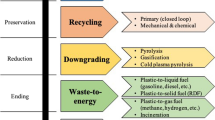Abstract
The world’s leading countries have reached a consensus concerning the need for environmental protection, and many international environmental protection rules and regulations have been implemented. Of these, the EU-legislated Restriction of the use of certain Hazardous Substances in electrical and electronic equipment (RoHS), Waste Electrical and Electronic Equipment (WEEE), and Eco-design of Energy-using Products (EuP) compel the electronics industry to incorporate waste disposal considerations in product design and manufacturing in order to benefit the environment. This study accordingly employed the ISO 14000 environmental management family’s ISO 14031 environmental performance evaluation (EPE) standards as an assessment framework, and investigated the types of factors influencing environmental performance, and their level of importance, when the electronics industry implements lead-free manufacturing. The study conducted a questionnaire survey of industry experts, scholars, and government officers in Taiwan and Japan—which constitute two of the world’s leading electronics product manufacturing centers—employing the Delphi method to extract assessment indicators, and using the Analytic Hierarchy Process (AHP) method to analyze indicators’ relative levels of importance. The results showed that the choice of lead-free substitute materials, soil heavy metal pollution, and compliance with environmental laws and regulations are the three important indicators of the environmental performance of lead-free manufacturing. As a consequence, when relevant industries adopt lead-free manufacturing in the future, they should first establish basic process technology, and also take their industries’ process characteristics and the suitability of substitute materials into consideration. In order to maintain compliance with laws and regulations, and to reduce pollution emissions, such industries should cooperate with government in connection with waste and wastewater treatment. In addition, apart from implementing environmental policies and testing standards, government can facilitate the realization of environmental protection policies and help conserve corporate resources by providing assistance, specialized training, and incentive measures to industry.
Similar content being viewed by others
References
Benjamin Y (2005) Industrial analytical technology forecasting methods and examples. McGraw-Hill, Taiwan
Deng C-Y, Tzeng K-H (1989) The intrinsic characteristics and application of the analytic hierarchy process (AHP) method. J Chin Stat Assoc 27(6/7):13707–13786
Eveloy V, Ganesan S, Fukuda Y, Wu J, Pecht MG (2005) WEEE, RoHS, and what you must do to get ready for lead-free electronics. In: IEEE 6th international conference on electronic packaging technology, pp 27–44
Feng C-M, Chiu Y-C (2004) Research analysis methods. Chien Tu Culture Publishing, Hsinchu
Fong CM, Chu YG (2004) The research analysis methods. Chien Du Publishing, Hsinchu, pp 111–118
Huang H-K (2004) Analysis of defects in lead-free soldering. Electron Test QC 57:36–42
Hwang CL, Yoon K (1981) Multiple attribute decision making methods and application. Springer-Verlag, New York
Industrial Development Bureau, MOEA (2000) ISO 14000 series—guide for establishment of environmental management systems at SMEs. Technical handbook
Lin W-W (2005) Lead-free product reliability testing technology. Electr Eng Inf 174:30–34
Method 1311 Toxicity Characteristic Leaching Procedure (TPLP). Federal Regist 61:11863–11877, Mar 1990
Official Journal of the European Union, Directive 2002/95/EC (2003a) Restriction of the use of certain hazardous substances in electrical and electronic equipment
Official Journal of the European Union, Directive 2002/96/EC (2003b) Waste electrical and electronic equipment
Roy B, Vincke Ph (1981a) Pseudo-orders: definition, properties and numerical representation. Math Soc Sci 14:263–274
Roy B, Vincke Ph (1981b) Multicriteria analysis: survey and new direction. Eur J Oper Res 8(3):207–218
Roy B, Vincke Ph (1984) Relational systems of preference with one or more pseudo-criteria: some new concepts and results. Manage Sci 30:1323–1335
Saaty TL (1977) A scaling method for priorities in the hierarchical structures. J Math Psychol 15(2):234–281
Smith EB, Swanger LK (1999) Are lead-free solders really environmental friendly? Surf Mount Technol March:64–66
Teng C-Y (2002) Project assessment: methods and applications. Planning and management research center books, Planning Center, National Taiwan Ocean University
Turbini LJ, Munie GC, Bernier D, Gamalski J, Bergman DW (2001) Examining the environmental impact of lead-free soldering alternatives. IEEE Trans Electron Packag Manuf 24(1):4–9
Voogd H (1982) Multicriteria evaluation with mixed qualitative and quantitative data. Environ Plan B: Plan Design 9(2):221–236
Voogd H (1983) Multicriteria evaluation for urban and regional planning. Pion Limited, London
Yang C-H (2004) Impact of the European Union’s RoHS directive and response by corporate green supply chains. Chemtech 15:79–84
Author information
Authors and Affiliations
Corresponding author
Rights and permissions
About this article
Cite this article
Chiang, SY., Wei, CC., Chiang, TH. et al. How can electronics industries become green manufacturers in Taiwan and Japan. Clean Techn Environ Policy 13, 37–47 (2011). https://doi.org/10.1007/s10098-010-0284-6
Received:
Accepted:
Published:
Issue Date:
DOI: https://doi.org/10.1007/s10098-010-0284-6




